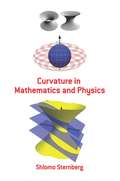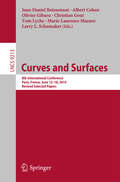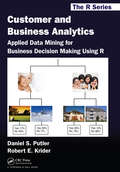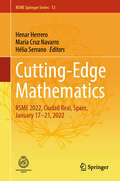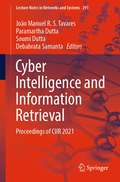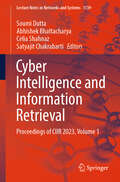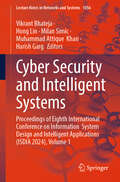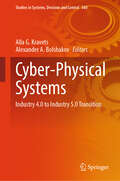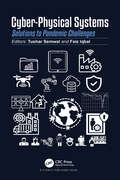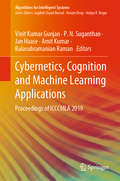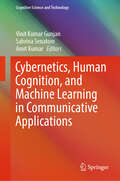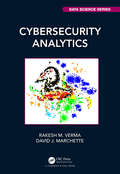- Table View
- List View
Curriculum for Wales: Mastering Mathematics for 11-14 years: Book 3
by Jonathan Agar Laszlo FedorCreate confident and capable mathematicians with accessible explanations and engaging activities.This book gradually builds on prior knowledge to deepen understanding through clear explanations, worked examples and hundreds of differentiated questions, as well as a range of activities that you can choose from to build your lessons and teaching plans. Designed to be used flexibly, this scheme covers the four 'what matters' statements and follows the five principles of progression from the Curriculum for Wales.- Develop pupils' conceptual understanding and communication with symbols throughout using plenty of worked examples and banded questions that get progressively more difficult- Target fluency, logical reasoning and strategic competence by using the markers included in each exercise question- Improve outcomes by selecting from banded questions most suited to enable progression- Ease the transition between progression steps with skill-checker activities at the start of each topic and review questions after each chapter - Link topics to other areas of learning, such as Science and Technology, with cross-curricular activities and discussion points- Improve pupils' understanding of maths in finance with a dedicated chapter and financial contexts highlighted throughout
Curvature Measures of Singular Sets (Springer Monographs in Mathematics)
by Martina Zähle Jan RatajThe book describes how curvature measures can be introduced for certain classes of sets with singularities in Euclidean spaces. Its focus lies on sets with positive reach and some extensions, which include the classical polyconvex sets and piecewise smooth submanifolds as special cases. The measures under consideration form a complete system of certain Euclidean invariants. Techniques of geometric measure theory, in particular, rectifiable currents are applied, and some important integral-geometric formulas are derived. Moreover, an approach to curvatures for a class of fractals is presented, which uses approximation by the rescaled curvature measures of small neighborhoods. The book collects results published during the last few decades in a nearly comprehensive way.
Curvature in Mathematics and Physics
by Shlomo SternbergThis original Dover textbook is based on an advanced undergraduate course taught by the author for more than 50 years. It introduces semi-Riemannian geometry and its principal physical application, Einstein's theory of general relativity, using the Cartan exterior calculus as a principal tool. Prerequisites include linear algebra and advanced calculus. 2012 edition.
Curved-Folding Origami Design (AK Peters/CRC Recreational Mathematics Series)
by Jun MitaniThe origami introduced in this book is based on simple techniques. Some were previously known by origami artists and some were discovered by the author. Curved-Folding Origami Design shows a way to explore new area of origami composed of curved folds. Each technique is introduced in a step-by-step fashion, followed by some beautiful artwork examples. A commentary explaining the theory behind the technique is placed at the end of each chapter. Features Explains the techniques for designing curved-folding origami in seven chapters Contains many illustrations and photos (over 140 figures), with simple instructions Contains photos of 24 beautiful origami artworks, as well as their crease patterns Some basic theories behind the techniques are introduced
Curves and Surfaces
by Larry L. Schumaker Pierre-Jean Laurent Alain Le MéhautéThis volume documents the results and presentations, related to aspects of geometric design, of the Second International Conference on Curves and Surfaces, held in Chamonix in 1993. The papers represent directions for future research and development in many areas of application. From the table of contents: - Object Oriented Spline Software - An Int
Curves and Surfaces (UNITEXT)
by M. Abate F. TovenaThe book provides an introduction to Differential Geometry of Curves and Surfaces. The theory of curves starts with a discussion of possible definitions of the concept of curve, proving in particular the classification of 1-dimensional manifolds. We then present the classical local theory of parametrized plane and space curves (curves in n-dimensional space are discussed in the complementary material): curvature, torsion, Frenet's formulas and the fundamental theorem of the local theory of curves. Then, after a self-contained presentation of degree theory for continuous self-maps of the circumference, we study the global theory of plane curves, introducing winding and rotation numbers, and proving the Jordan curve theorem for curves of class C2, and Hopf theorem on the rotation number of closed simple curves. The local theory of surfaces begins with a comparison of the concept of parametrized (i.e., immersed) surface with the concept of regular (i.e., embedded) surface. We then develop the basic differential geometry of surfaces in R3: definitions, examples, differentiable maps and functions, tangent vectors (presented both as vectors tangent to curves in the surface and as derivations on germs of differentiable functions; we shall consistently use both approaches in the whole book) and orientation. Next we study the several notions of curvature on a surface, stressing both the geometrical meaning of the objects introduced and the algebraic/analytical methods needed to study them via the Gauss map, up to the proof of Gauss' Teorema Egregium. Then we introduce vector fields on a surface (flow, first integrals, integral curves) and geodesics (definition, basic properties, geodesic curvature, and, in the complementary material, a full proof of minimizing properties of geodesics and of the Hopf-Rinow theorem for surfaces). Then we shall present a proof of the celebrated Gauss-Bonnet theorem, both in its local and in its global form, using basic properties (fully proved in the complementary material) of triangulations of surfaces. As an application, we shall prove the Poincaré-Hopf theorem on zeroes of vector fields. Finally, the last chapter will be devoted to several important results on the global theory of surfaces, like for instance the characterization of surfaces with constant Gaussian curvature, and the orientability of compact surfaces in R3.
Curves and Surfaces: 8th International Conference, Paris, France, June 12-18, 2014, Revised Selected Papers (Lecture Notes in Computer Science #9213)
by Albert Cohen Tom Lyche Larry L. Schumaker Jean-Daniel Boissonnat Olivier Gibaru Christian Gout Marie-Laurence MazureThis volume constitutes the thoroughly refereed post-conference proceedings of the 8th International Conference on Curves and Surfaces, held in Paris, France, in June 2014. The conference had the overall theme: "Representation and Approximation of Curves and Surfaces and Applications". The 32 revised full papers presented were carefully reviewed and selected from 39 submissions. The scope of the conference was on following topics: approximation theory, computer-aided geometric design, computer graphics and visualization, computational geometry and topology, geometry processing, image and signal processing, interpolation and smoothing, mesh generation, finite elements and splines, scattered data processing and learning theory, sparse and high-dimensional approximation, subdivision, wavelets and multi-resolution method.
Custom Search - Discover more: A Complete Guide to Google Programmable Search Engines
by Irina Shamaeva David Michael GalleyGoogle’s Programmable Search Engines (PSEs, previously called Custom Search Engines) provide search opportunities that are unavailable with any other tool. PSEs have advanced settings and search operators that are not supported by "regular" Google. With PSEs, it is possible to perform filtered searches within parts of the web as if they were databases! While lots of professionals use existing PSEs to source for talent or with other research goals, few people have experience creating them. Even fewer know about powerful PSE-only search operators. The main reason PSEs are not as popular as they should be is that it is not easy to get educated on PSE creation. There is little information online and no books (other than this one) on the subject. Even less info is available on the "structured" operators that allow for filtered searches. The first of its kind, this book hopes to popularize these fun and powerful tools so that many more people can include PSEs in their work. Key Features: A detailed introduction to creating PSEs, including info absent in Google’s help A "hack" for creating PSEs that look for profiles in seconds An introduction to advanced PSE-only search operators allowed to perform filtered searches of parts of the web A "hack" for expanding Google’s search limits to 500 terms Use cases, examples, and approaches that would be educational for those doing online research This book will be of interest to researchers, OSINT specialists, investigative journalists, Competitive Intelligence people, recruiters, and Sourcers, to name a few categories, and to the general public interested in how to search better.
Customer and Business Analytics: Applied Data Mining for Business Decision Making Using R
by Daniel S. Putler Robert E. KriderCustomer and Business Analytics: Applied Data Mining for Business Decision Making Using R explains and demonstrates, via the accompanying open-source software, how advanced analytical tools can address various business problems. It also gives insight into some of the challenges faced when deploying these tools. Extensively classroom-tested, the tex
Customizable and Adaptive Quantum Processors: Theory and Applications
by Nadia Nedjah Luiza De Macedo MourelleThe book describes state-of-the-art advances in simulators and emulators for quantum computing. It introduces the main concepts of quantum computing, defining q-bits, explaining the parallelism behind any quantum computation, describing measurement of the quantum state of information and explaining the process of quantum bit entanglement, collapsed state and cloning. The book reviews the concept of quantum unitary, binary and ternary quantum operators as well as the computation implied by each operator. It provides details of the quantum processor, providing its architecture, which is validated via execution simulation of some quantum instructions.
Cutting-Edge Mathematics: RSME 2022, Ciudad Real, Spain, January 17–21, 2022 (RSME Springer Series #13)
by Henar Herrero María Cruz Navarro Hélia SerranoThe book contains a selection of research and expository papers in pure and applied mathematics presented by various authors as plenary or invited speakers at the biennial congress of the Spanish Royal Mathematical Society held in Ciudad Real (Spain) in January 2022. The main results focus on the Yang problem and its solution proposed by Globevnik; a phylogenetic reconstruction based on algebra; the Calderon problem for local and nonlocal Schrödinger equations; some open problems in orthogonal polynomial theory; Quillen’s rational homotopy theory; Ulrich bundles and applications; and free objects in theory of Banach spaces. Researchers in these fields are potential audiences.
Cyber Intelligence and Information Retrieval: Proceedings of CIIR 2021 (Lecture Notes in Networks and Systems #291)
by João Manuel R. S. Tavares Paramartha Dutta Soumi Dutta Debabrata SamantaThis book gathers a collection of high-quality peer-reviewed research papers presented at International Conference on Cyber Intelligence and Information Retrieval (CIIR 2021), held at Institute of Engineering & Management, Kolkata, India during 20–21 May 2021. The book covers research papers in the field of privacy and security in the cloud, data loss prevention and recovery, high-performance networks, network security and cryptography, image and signal processing, artificial immune systems, information and network security, data science techniques and applications, data warehousing and data mining, data mining in dynamic environment, higher-order neural computing, rough set and fuzzy set theory, and nature-inspired computing techniques.
Cyber Intelligence and Information Retrieval: Proceedings of CIIR 2023, Volume 1 (Lecture Notes in Networks and Systems #1139)
by Satyajit Chakrabarti Abhishek Bhattacharya Soumi Dutta Celia ShahnazThis book gathers a collection of high-quality peer-reviewed research papers presented at International Conference on Cyber Intelligence and Information Retrieval (CIIR 2023), held at Institute of Engineering & Management, Kolkata, India during 14 – 15 December 2023. The book covers research papers in the field of privacy and security in the cloud, data loss prevention and recovery, high performance networks, network security and cryptography, image and signal processing, artificial immune systems, information and network security, data science techniques and applications, data warehousing and data mining, data mining in dynamic environment, higher order neural computing, rough set and fuzzy set theory, and nature inspired computing techniques.
Cyber Intelligence and Information Retrieval: Proceedings of CIIR 2023, Volume 2 (Lecture Notes in Networks and Systems #1025)
by Satyajit Chakrabarti Abhishek Bhattacharya Soumi Dutta Celia ShahnazThis book features selected research papers presented at the 2nd International Conference on Cyber Intelligence and Information Retrieval (CIIR 2023) held at the Institute of Engineering & Management, Kolkata, India, in association with CSI Kolkata section on 14-15 December 2023. Cyber intelligence and information retrieval are closely related fields that deal with the collection, analysis, and utilization of data and information from various digital sources. These fields are crucial in today's digital age, where vast amounts of data are generated and stored electronically. By combining the strengths of cyber intelligence and information retrieval, organizations can enhance their ability to detect, respond to, and mitigate cyber threats, while also improving their overall cybersecurity posture and decision-making processes. This book comprises high-quality research work by academicians and industrial experts in the field of artificial intelligence, data analytics, computing, and communication, including full-length papers, research-in-progress papers, and case studies related to all the areas of data analytics, machine learning, Internet of Things (IoT), information security, etc.
Cyber Security and Intelligent Systems: Proceedings of Eighth International Conference on Information System Design and Intelligent Applications (ISDIA 2024), Volume 1 (Lecture Notes in Networks and Systems #1056)
by Vikrant Bhateja Hong Lin Harish Garg Milan Simic Muhammad Attique KhanThis book presents a collection of high-quality, peer-reviewed research papers from the 8th International Conference on Information System Design and Intelligent Applications (ISDIA 2024), held in Dubai, UAE, from 3-4 January 2024. It covers a wide range of topics in computer science and information technology, including data mining and data warehousing, high-performance computing, parallel and distributed computing, computational intelligence, soft computing, big data, cloud computing, grid computing, cognitive computing, and information security.
Cyber Security, Cryptology, and Machine Learning: 8th International Symposium, CSCML 2024, Be'er Sheva, Israel, December 19–20, 2024, Proceedings (Lecture Notes in Computer Science #15349)
by Giuseppe Persiano Shlomi Dolev Mirosław Kutyłowski Michael ElhadadThis book constitutes the proceedings of the 8th International Symposium on Cyber Security, Cryptology, and Machine Learning, CSCML 2024, held in Be'er Sheva, Israel, during December 19–20, 2024. The 16 full papers and 11 short papers presented here were carefully reviewed and selected from 43 submissions. These papers focus on the current innovative research developments in the field of cyber security, cryptography, and machine learning systems and networks.
Cyber-Physical Systems Security: A Multi-disciplinary Approach (Studies in Big Data #154)
by Vinay Kumar Amitava Choudhury Keshav Kaushik Binod Kumar SinghThis book is a comprehensive and cutting-edge exploration of the complexities surrounding the protection and resilience of cyber-physical systems. It delves into the critical interplay between physical components and computer systems in various domains, such as transportation, health care, manufacturing, and energy systems. The technical content of the book is divided into multiple sections, each meticulously crafted to address the key challenges and methodologies relevant to securing cyber-physical systems. The book examines the current state-of-the-art in cyber-physical systems security, showcasing the latest research findings and theoretical discussions. Key topics include the integration of technologies like IoT, AI, machine learning, and embedded systems within cyber-physical systems, and how security considerations can be effectively woven into these technologies. By adopting a multi-disciplinary approach, this book provides readers with an encompassing view of the subject matter, ensuring that both technical specialists and professionals from diverse backgrounds can benefit from its insights. The book includes practical applications and real-world case studies to illustrate how security methods and models can be successfully deployed in various scenarios. By bridging the gap between theory and practice, this book equips the readers with invaluable tools to address security challenges effectively, ensuring the resilience and reliability of the cyber-physical systems of the future.
Cyber-Physical Systems: Industry 4.0 to Industry 5.0 Transition (Studies in Systems, Decision and Control #560)
by Alla G. Kravets Alexander A. BolshakovThis book presents a comprehensive overview of the latest advancements in the field of cyber-physical systems, focusing on the transition from Industry 4.0 to Industry 5.0. This transition emphasizes the increased role of humans in the manufacturing process, the introduction of new technologies, and improvements in management and security. The book covers various topics, including neural network and synergetic approaches to solving problems, decentralized identifiers methods classification, identification of technological opportunities for enterprises, and cybernetic technologies to counter passive and active cyberattacks. This book is an essential resource for researchers, engineers, and students interested in the field of cyber-physical systems, as well as for professionals working in industries that are undergoing the transition from Industry 4.0 to Industry 5.0.
Cyber-Physical Systems: Solutions to Pandemic Challenges
by Tushar SemwalA Cyber-Physical System (CPS) is an integration of cyber components with their physical counterparts. A cyber unit could be either a software or hardware. Physical components are those objects, which are governed by the law of physics. CPS have transformed how we interact with the physical world, ranging from sensing the environmental parameters to controlling a complex manufacturing industry. The current pandemic has had catastrophic implications people all across the world in terms of health and economy. This book presents the significance and practicality of CPS in a pandemic situation. It provides a strong foundation to the CPS while also incorporating the latest theoretical advances and practical applications to alleviate the state of a pandemic. The book covers… Theoretical background and application-oriented overview of the different CPS models Impact of COVID-19 and similar pandemics on the engineering aspects of various industries and organisations Exciting and impactful CPS based solutions to the different pandemic situations Security and privacy in CPS when applied to critical and sensitive pandemic affected environment Describes the government-funded projects and work using CPS in real-world scenarios The book provides a unique and fresh exposure to CPS employed in a pandemic situation. It brings together researchers, practitioners, academics, experts, and industry professionals from around the world to share their knowledge and experience.
Cyber-Security in Critical Infrastructures: A Game-Theoretic Approach (Advanced Sciences and Technologies for Security Applications)
by Quanyan Zhu Stefan Rass Stefan Schauer Sandra KönigThis book presents a compendium of selected game- and decision-theoretic models to achieve and assess the security of critical infrastructures. Given contemporary reports on security incidents of various kinds, we can see a paradigm shift to attacks of an increasingly heterogeneous nature, combining different techniques into what we know as an advanced persistent threat. Security precautions must match these diverse threat patterns in an equally diverse manner; in response, this book provides a wealth of techniques for protection and mitigation. Much traditional security research has a narrow focus on specific attack scenarios or applications, and strives to make an attack “practically impossible.” A more recent approach to security views it as a scenario in which the cost of an attack exceeds the potential reward. This does not rule out the possibility of an attack but minimizes its likelihood to the least possible risk. The book follows this economic definition of security, offering a management scientific view that seeks a balance between security investments and their resulting benefits. It focuses on optimization of resources in light of threats such as terrorism and advanced persistent threats. Drawing on the authors’ experience and inspired by real case studies, the book provides a systematic approach to critical infrastructure security and resilience. Presenting a mixture of theoretical work and practical success stories, the book is chiefly intended for students and practitioners seeking an introduction to game- and decision-theoretic techniques for security. The required mathematical concepts are self-contained, rigorously introduced, and illustrated by case studies. The book also provides software tools that help guide readers in the practical use of the scientific models and computational frameworks.
Cybernetics, Cognition and Machine Learning Applications: Proceedings of ICCCMLA 2019 (Algorithms for Intelligent Systems)
by Amit Kumar Vinit Kumar Gunjan Jan Haase Balasubramanian Raman P. N. SuganthanThis book provides a collection of selected papers presented at the International Conference on Cybernetics, Cognition and Machine Learning Applications (ICCCMLA 2019), which was held in Goa, India, on 16–17 August 2019. It covers the latest research trends and advances in the areas of data science, artificial intelligence, neural networks, cognitive science and machine learning applications, cyber-physical systems, and cybernetics.
Cybernetics, Human Cognition, and Machine Learning in Communicative Applications (Cognitive Science and Technology)
by Amit Kumar Vinit Kumar Gunjan Sabrina SenatoreThis book presents the fascinating intersection of human cognition and artificial intelligence. Written by leading experts in the fields of cybernetics, cognitive science, and machine learning, this book seeks to bridge the gap between these disciplines and explores the synergies that emerge when humans and machines work together. The book examines the challenges posed by biased data, lack of transparency, and the "black box" nature of some machine learning algorithms. It proposes novel ways to address these issues and foster greater trust and accountability in AI systems. Drawing on cutting-edge research and real-world case studies, it presents a comprehensive and forward-looking perspective on the future of AI and its impact on society. In conclusion, this book offers a compelling exploration of the synergy between human cognition and machine learning, providing insights that are relevant to scholars, researchers, policymakers, and anyone interested in the transformative potential of artificial intelligence.
Cybersecurity Analytics (Chapman & Hall/CRC Data Science Series)
by Rakesh M. Verma David J. MarchetteCybersecurity Analytics is for the cybersecurity student and professional who wants to learn data science techniques critical for tackling cybersecurity challenges, and for the data science student and professional who wants to learn about cybersecurity adaptations. Trying to build a malware detector, a phishing email detector, or just interested in finding patterns in your datasets? This book can let you do it on your own. Numerous examples and datasets links are included so that the reader can "learn by doing." Anyone with a basic college-level calculus course and some probability knowledge can easily understand most of the material. The book includes chapters containing: unsupervised learning, semi-supervised learning, supervised learning, text mining, natural language processing, and more. It also includes background on security, statistics, and linear algebra. The website for the book contains a listing of datasets, updates, and other resources for serious practitioners.
Cybersecurity and High-Performance Computing Environments: Integrated Innovations, Practices, and Applications
by Kuan-Ching LiIn this fast-paced global economy, academia and industry must innovate to evolve and succeed. Today’s researchers and industry experts are seeking transformative technologies to meet the challenges of tomorrow. Cutting-edge technological advances in cybersecurity solutions aid in enabling the security of complex heterogeneous high-performance computing (HPC) environments. On the other hand, HPC facilitates powerful and intelligent innovative models for reducing time to response to identify and resolve a multitude of potential, newly emerging cyberattacks. Cybersecurity and High-Performance Computing Environments provides a collection of the current and emergent research innovations, practices, and applications focusing on the interdependence of cybersecurity and HPC domains for discovering and resolving new emerging cyber-threats. KEY FEATURES Represents a substantial research contribution to the state-of-the-art solutions for addressing the threats to confidentiality, integrity, and availability (CIA triad) in HPC environments Covers the groundbreaking and emergent solutions that utilize the power of the HPC environments to study and understand the emergent, multifaceted, anomalous, and malicious characteristics The content will help university students, researchers, and professionals understand how HPC research fits broader cybersecurity objectives and vice versa.
Cybersecurity for Everyone
by David B. SkillicornCyberspace is a critical part of our lives. Although we all use cyberspace for work, entertainment, and social life, much of its infrastructure and operation is invisible to us. We spend a big part of our lives in an environment that is almost an essential service but is full of potential dangers: a place where criminals can commit new kinds of crimes, where governments can exert political pressure, and where we can be hurt by the unthinking actions of the bored and careless. Making cyberspace more secure is one of the challenges of our times. This is not only (or perhaps even primarily) a technical challenge. It requires actions by governments and businesses to encourage security whenever possible, and to make sure that their own actions do not undermine it. Unfortunately, many of those in a position to do something about cybersecurity do not have the background to understand the issues fully. Cybersecurity for Everyone will help by describing the issues in a way that is accessible to anyone, but especially those from non-technical backgrounds.


